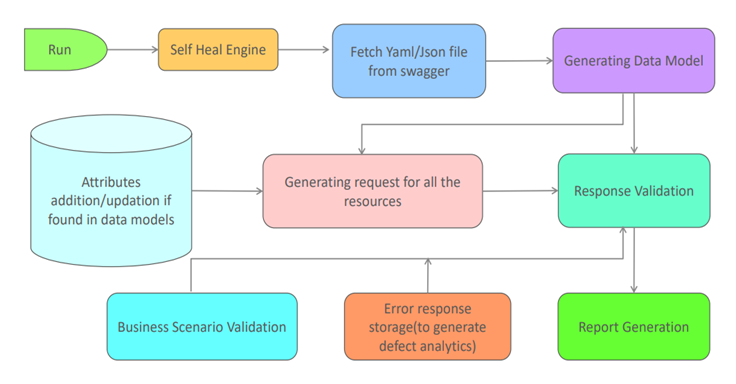Transform API Testing Efficiency: Self-Healing Automation Cuts 50% of Maintenance Efforts
Tired of spending countless hours troubleshooting failed API tests and keeping up with constant schema changes? What if there was a way to automate these updates and eliminate manual maintenance altogether?
Manual API testing and maintenance are often time-consuming and prone to errors. It requires teams to debug failures, review API Swagger specifications for changes, and manually update scripts. However, self-healing API automation process is changing the game. By using an AI-powered plugin, it detects changes in Swagger schemas, automatically updates test scripts during runtime, and prevents failures before they occur.
By automating error detection and script updates, a self-healing API automation solution reduces maintenance efforts, accelerates agile workflows, and boosts productivity. This makes API testing faster, smarter, and more efficient. The best part? It seamlessly integrates into your processes, ensuring reliable and accurate test results while increasing confidence in delivering high-quality APIs. So, how can self-healing automation truly transform API testing?
Self-Healing Test Automation for APIs: Why It’s Essential?
Self-healing test automation ensures consistent and reliable API testing by scanning API Swagger specification files, detecting changes in data models or schemas, and updating test scripts accordingly. It can even generate test scripts based on Swagger specs. Here’s why adopting self-healing API automation is a game-changer:
1. Low Maintenance
API testing automation frequently encounters changes in Swagger schemas and data models, with new attributes or properties being added or removed. Traditional testing methods require constant manual script updates to adapt to these changes, which can be both time-consuming and effort-intensive. Self-healing test automation significantly reduces maintenance efforts and speeds up the testing process by automating these updates.
2. Improved Efficiency
Manual error detection and script fixes can slow down API testing automation workflows. Self-healing automation accelerates this process by automatically identifying Swagger changes, thus improving workflow efficiency, and enabling faster delivery.
3. Auto Test Generation
Manually creating test scripts based on Swagger specifications is a time-intensive task. Self-healing automation simplifies this by generating test scripts automatically, saving time and effort while ensuring accuracy.
4. Reduced Costs
The manual effort required for testing and maintaining API automation scripts can be resource-intensive and costly. By automatically detecting Swagger changes and fixing errors, self-healing automation provides a cost-effective solution over time, optimizing both resources and budgets. Isn’t this a major advantage in today’s fast-paced business world?
Self-healing API automation offers a smarter, faster, and more efficient approach to testing, making it an indispensable tool for modern agile and in-sprint workflows.
Self-Heal API Automation Mechanism
Let’s take a closer look at how the self-healing API process works:

1. Self-heal Engine
This crucial step injects self-healing test automation for APIs into the testing framework. If user has a Maven-based automation farmework, the plugin can be added as a Maven dependency, enabling the healing functionality. Think of this as setting up a system that automatically checks and fixes your tests, without needing constant manual updates.
2. Fetch YAML/JSON File from Swagger1
RESTful APIs are documented and described with Swagger. It allows us to clearly define how an API works, what inputs it expects, and what outputs it returns. Swagger specifications can be written in YAML or JSON format, which are the data structures required for self-healing API automation. This step involves scanning through the Swagger specification (in either YAML or JSON format) to extract all the relevant details about the API’s endpoints, inputs, outputs, and data structures.
3. Generating Data Models
Data models, also known as schemas, are generated when the self-heal engine scans the API Swagger. These models contain all the properties and data values. This generation helps to fetch all API resources and makes them available to users. In simpler terms, the self-heal engine reads the Swagger blueprint and creates a map of all the different parts of the API, including its data types and properties.
4. Generating Request and Response
Once the data models are generated, the healing process fetches all the available requests and responses for all the resources. API testing automation requires payloads for all API resources. This is where the self-heal engine figures out what information (requests) your API needs and what it gives back (responses), ensuring it matches the blueprint.
5. Attributes Addition/Updation
Attributes and values are updated in the local data file, making them easy for users to utilize at the framework level. If there’s an update in the Swagger, the stored data will be updated accordingly. This ensures that any changes in API specifications (like new attributes, removed properties, or schema updates) are automatically reflected in the test scripts, reducing manual effort and keeping the system current.
6. Response Validation
Self-healing test automation for API process enables schema validation by comparing the current run to previous one to detect changes. The healing process ensures accurate response data validation. Simply put, this validates whether the response from an API call still meet the expected schema, helping catch potential issues early and maintain accuracy across API interactions.
7. Business Scenario Validation
Validating business scenarios in automated test scrpts is crucial to ensure the application behaves as expected in real time. The self-heal system identifies the business test scenario’s, though certain data updates may require users to manually adjust business test data, like, for example the PNR of airlines. This checks whether specific end-user scenarios (like booking a flight or ordering items) still function correctly, ensuring that the API works as it should in practical applications.
8. Defect Analytics
The self-heal API process stores error response codes from API testing automation endpoints for every automation run. This enables quick turnarounds and early defect identification. Think of this as a smart system that learns from past errors, allowing for faster resolution of problems and continuous improvement of the API’s performance.
9. Enable Contract Testing
Quality engineers face challenges when API endpoints/contracts frequently change. Self-heal API automation detects these changes, ensuring contract testing is continuously aligned with the latest specifications. This ensures that even if the contract between the API provider and the consumer changes, your tests stay valid and comprehensive.
10. Report Generation
The tool is capable of generating HTML reports that contain resource and payload details fetched via Swagger specifications. It also provides dashboard capabilities for data analytics in API testing automation. This allows for a comprehensive view of test results, performance metrics, and any issues identified, making reporting easier and enabling better decision-making.
How Does Self-Heal API Automation Apply Across Industries?
Self-heal API automation offers a transformative solution for the software testing industry, particularly when development teams use API Swagger or Swagger Hub for documentation. The self-healing mechanism detects changes in Swagger specifications and resolves issues within automation tests seamlessly. This solution is highly adaptable and can be implemented across industries such as travel, transport, hospitality, retail, and insurance, enabling faster, more reliable API test automation.
Swagger is a tool that helps document RESTful APIs. It’s a set of standards that provides a clear structure for how APIs should be described and used. In API testing, Swagger is often used to define the API’s operations and inputs, making it easier to develop and test.
Key Benefits
Boosted Productivity: Post-integration, teams can deliver more story points within agile processes, enhancing overall output.
Faster Turnaround: The system quickly addresses Swagger changes, reducing downtime and accelerating project timelines.
Conclusion
Self-healing in quality engineering, particularly in test automation, enhances Quality Assurance and API test stability. Self-heal test automation, an AI-powered plugin, is a transformative solution for API testing. It integrates seamlessly into automation frameworks to identify and resolve API attribute discrepancies in real-time, eliminating manual troubleshooting and significantly reducing maintenance efforts.
By automating script updates and addressing evolving Swagger specifications, it ensures efficiency, reliability, and substantial ROI. This innovative approach transforms API testing by streamlining processes, minimizing delays, and future-proofing automation investments. Adopting self-healing automation not only optimizes your current testing workflow but also equips your team to effortlessly adapt to future API demands and changes.
Reference
Swagger Documentation: https://swagger.io/docs/
Latest Blogs
Core banking platforms like Temenos Transact, FIS® Systematics, Fiserv DNA, Thought Machine,…
We are at a turning point for healthcare. The complexity of healthcare systems, strict regulations,…
Clinical trials evaluate the efficacy and safety of a new drug before it comes into the market.…
Introduction In the upstream oil and gas industry, drilling each well is a high-cost, high-risk…




